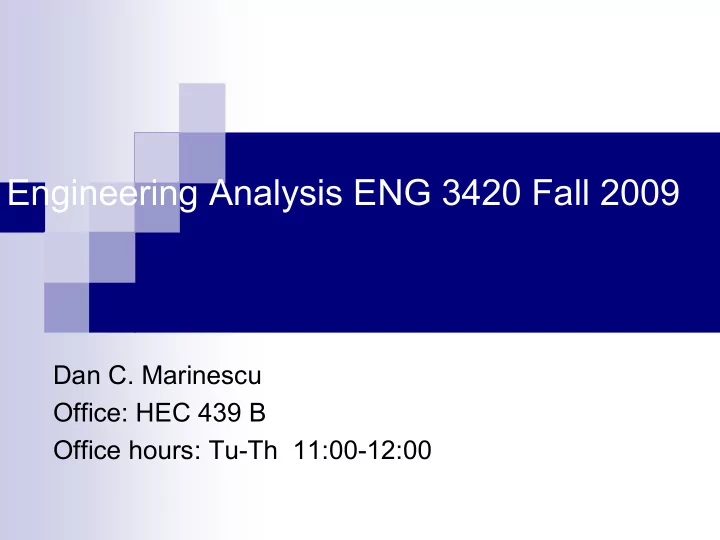

Engineering Analysis ENG 3420 Fall 2009 Dan C. Marinescu Office: HEC 439 B Office hours: Tu-Th 11:00-12:00
Lecture 20 � Last time: � The inverse of a matrix � Iterative methods for solving sytems of linear equations � Gauss-Siedel � Jacobi � Today � Relaxation � Non-linear systems � Random variables, probability distributions, Matlab support for random variables. � Next Time � Linear regression � Linear least squares regression Lecture 20 2
Relaxation � To enhance convergence, an iterative program can introduce relaxation where the value at a particular iteration is made up of a combination of the old value and the newly calculated value: new = λ x i new + 1 − λ ( ) x i old x i where λ is a weighting factor that is assigned a value between 0 and 2. � 0< λ <1: underrelaxation � λ =1: no relaxation � 1< λ ≤ 2: overrelaxation
Nonlinear Systems � Nonlinear systems can also be solved using the same strategy as the Gauss-Seidel method - solve each system for one of the unknowns and update each unknown using information from the previous iteration. � This is called successive substitution .
Newton-Raphson � Nonlinear systems may also be solved using the Newton-Raphson method for multiple variables. � For a two-variable system, the Taylor series approximation and resulting Newton-Raphson equations are: ∂ f 2, i ∂ f 1, i − f 2, i f 1, i ∂ f 1, i ∂ f 1, i ∂ x 2 ∂ x 2 ( ) ( ) f 1, i + 1 = f 1, i + x 1, i + 1 − x 1, i + x 2, i + 1 − x 2, i x 1, i + 1 = x 1, i − ∂ f 1, i ∂ f 2, i − ∂ f 1, i ∂ f 2, i ∂ x 1 ∂ x 2 ∂ x 1 ∂ x 2 ∂ x 2 ∂ x 1 ∂ f 1, i ∂ f 2, i − f 1, i f 2, i ∂ f 2, i ∂ f 2, i ∂ x 1 ∂ x 1 ( ) ( ) f 2, i + 1 = f 2, i + x 1, i + 1 − x 1, i + x 2, i + 1 − x 2, i x 2, i + 1 = x 2, i − ∂ f 1, i ∂ f 2, i − ∂ f 1, i ∂ f 2, i ∂ x 1 ∂ x 2 ∂ x 1 ∂ x 2 ∂ x 2 ∂ x 1
Probability and statistics concepts � See class notes: � Probability � NASA lecture
Recommend
More recommend